Planet View: S14°17.752′ E126°38.644′
Street View: S14°17.752′ E126°38.644′
 A few hours’ drive from Drysdale Station along some of the worst road we’ve encountered thus far brought us to the small Aboriginal community of Kalumburu. Initially established as a mission by Spanish monks of the Catholic Church, today Kalumburu is a community run jointly by the local Kalumburu Aboriginal Corporation and the Kalumburu Mission. Kalumburu is the most northerly point in Western Australia accessible by road, a good spot for us to top up with fuel and restock with a few small things from the community store. All of Kalumburu’s food and fuel supplies are delivered to the town via barge, so fuel is especially expensive as it is transported in drums. My eyes almost popped out of my head when I saw the diesel price:
A few hours’ drive from Drysdale Station along some of the worst road we’ve encountered thus far brought us to the small Aboriginal community of Kalumburu. Initially established as a mission by Spanish monks of the Catholic Church, today Kalumburu is a community run jointly by the local Kalumburu Aboriginal Corporation and the Kalumburu Mission. Kalumburu is the most northerly point in Western Australia accessible by road, a good spot for us to top up with fuel and restock with a few small things from the community store. All of Kalumburu’s food and fuel supplies are delivered to the town via barge, so fuel is especially expensive as it is transported in drums. My eyes almost popped out of my head when I saw the diesel price: 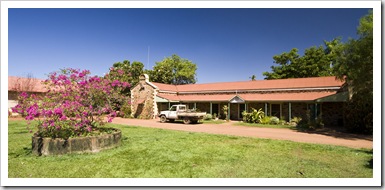 $2.60 per liter (that’s around $USD8.20 per gallon)! Luckily we have two fuel tanks and only needed a small top up.
$2.60 per liter (that’s around $USD8.20 per gallon)! Luckily we have two fuel tanks and only needed a small top up.
The Kalumburu Mission is a very well kept property in the center of town, beautiful lawns and 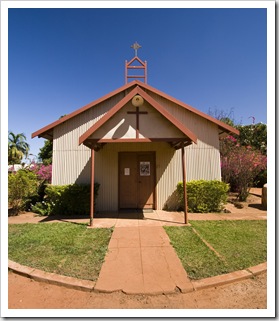 bougainvilleas cover the Mission’s grounds and some of the historic buildings are beautifully maintained. The Mission also runs a campground adjacent to the Mission’s store and cafe, we stayed there for our first and also last night in the area,
bougainvilleas cover the Mission’s grounds and some of the historic buildings are beautifully maintained. The Mission also runs a campground adjacent to the Mission’s store and cafe, we stayed there for our first and also last night in the area, 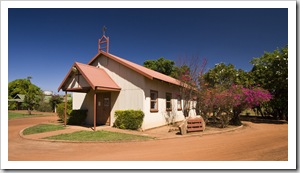 excellent facilities with a camp kitchen and even a chance to catch up on the news on TV. On our first night staying at the Mission we decided to cleanse our souls by attending Catholic mass at 5:00PM, the legally blind priest was assisted by his junior priest-in-training from Kenya, it’d been a while since either of us had attended mass so we stumbled along without trying to look too out of place! Recommended to us by a couple of travelers we met, we took a guided tour of the Mission grounds and the newly renovated museum. The priest holds guided tours for $10 per head every second day, it was a very interesting couple of hours, the priest was an absolute wealth of information on the establishment of the community and the evolution of the town through wars, bombings, the Whitlam years and into modern times. The museum itself boasted a huge collection of authentic Aboriginal artifacts as well as quite a trove of relics from World War II, during which time Kalumburu was extensively bombed by the Japanese.
excellent facilities with a camp kitchen and even a chance to catch up on the news on TV. On our first night staying at the Mission we decided to cleanse our souls by attending Catholic mass at 5:00PM, the legally blind priest was assisted by his junior priest-in-training from Kenya, it’d been a while since either of us had attended mass so we stumbled along without trying to look too out of place! Recommended to us by a couple of travelers we met, we took a guided tour of the Mission grounds and the newly renovated museum. The priest holds guided tours for $10 per head every second day, it was a very interesting couple of hours, the priest was an absolute wealth of information on the establishment of the community and the evolution of the town through wars, bombings, the Whitlam years and into modern times. The museum itself boasted a huge collection of authentic Aboriginal artifacts as well as quite a trove of relics from World War II, during which time Kalumburu was extensively bombed by the Japanese.
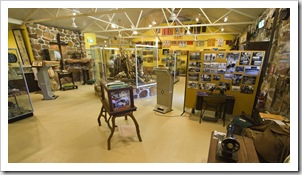
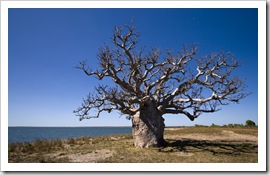 We spent a few days exploring the remote coves and beaches to the north of Kalumburu, notably McGowan’s Island, Honeymoon Bay and the area north of Pago. Honeymoon Bay has a campsite run by a local Aboriginal family, the inlet and beaches were very picturesque but unfortunately the camping area has been allowed to fall into a bit of
We spent a few days exploring the remote coves and beaches to the north of Kalumburu, notably McGowan’s Island, Honeymoon Bay and the area north of Pago. Honeymoon Bay has a campsite run by a local Aboriginal family, the inlet and beaches were very picturesque but unfortunately the camping area has been allowed to fall into a bit of 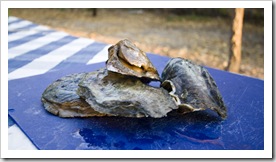 a state of disrepair. Lisa’s mum had recommended we stop off at Honeymoon to
a state of disrepair. Lisa’s mum had recommended we stop off at Honeymoon to 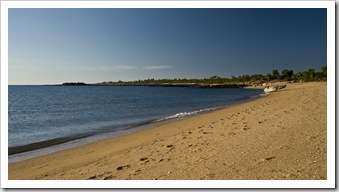 hunt for oysters on the rocks but everywhere we looked the rocks had been picked clean. We ended up staying one night at the next camping spot south of Honeymoon, McGowan’s Island. While the campground was quite packed,
hunt for oysters on the rocks but everywhere we looked the rocks had been picked clean. We ended up staying one night at the next camping spot south of Honeymoon, McGowan’s Island. While the campground was quite packed, 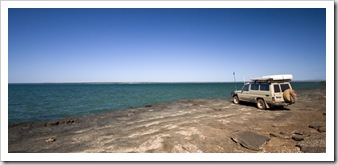 the scenic sites on the edge of the sand provided excellent access to the beach and unparalleled sunset views. We had a bit more luck hunting for oysters at McGowan’s Island, we had to work hard for them as the rocks had been well picked over but Hunter Lisa found a hidden stash under a rock ledge which provided us a nice little accompaniment to dinner. The fishing at McGowan’s Island was also a bit of fun, we spent the afternoon pulling in all manner of rock fish from the outcroppings alongside the beach. I saw a few anglers pull in some Trevally and Queenfish, we weren’t that lucky and returned all our reef fish to the ocean to fight another day.
the scenic sites on the edge of the sand provided excellent access to the beach and unparalleled sunset views. We had a bit more luck hunting for oysters at McGowan’s Island, we had to work hard for them as the rocks had been well picked over but Hunter Lisa found a hidden stash under a rock ledge which provided us a nice little accompaniment to dinner. The fishing at McGowan’s Island was also a bit of fun, we spent the afternoon pulling in all manner of rock fish from the outcroppings alongside the beach. I saw a few anglers pull in some Trevally and Queenfish, we weren’t that lucky and returned all our reef fish to the ocean to fight another day.
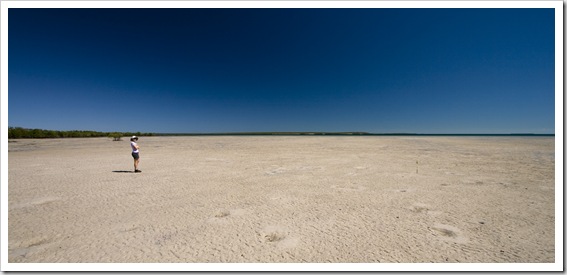 After our night at McGowan’s Island the plan was to head back to the Mission for one more night and then make our way south to Mitchell Falls. Before heading back to the Mission, however, we wanted to see the ruins at Pago, the site of the original mission setup by Spanish Catholic monks in the early 1900s. Pago was a further 10 or so kilometers north of McGowan’s Island, we were both amazed that missionaries survived in the bush there more than 100 years ago. Some of the masonry work at the original mission was astonishing, huge stone slabs arranged with only hand tools and an array of artesian wells were somehow constructed surrounding the foundation. The land around the Pago ruins is owned by an Aboriginal family that live a few hundred meters from the ruin site, we ventured down to say hello and ask if we could drive further up the track to explore and they kindly obliged. The seemingly endless mudflats pictured here to the right were located just in front of their house. Although we were planning to return to Kalumburu for the night, the Aboriginal family mentioned that
After our night at McGowan’s Island the plan was to head back to the Mission for one more night and then make our way south to Mitchell Falls. Before heading back to the Mission, however, we wanted to see the ruins at Pago, the site of the original mission setup by Spanish Catholic monks in the early 1900s. Pago was a further 10 or so kilometers north of McGowan’s Island, we were both amazed that missionaries survived in the bush there more than 100 years ago. Some of the masonry work at the original mission was astonishing, huge stone slabs arranged with only hand tools and an array of artesian wells were somehow constructed surrounding the foundation. The land around the Pago ruins is owned by an Aboriginal family that live a few hundred meters from the ruin site, we ventured down to say hello and ask if we could drive further up the track to explore and they kindly obliged. The seemingly endless mudflats pictured here to the right were located just in front of their house. Although we were planning to return to Kalumburu for the night, the Aboriginal family mentioned that 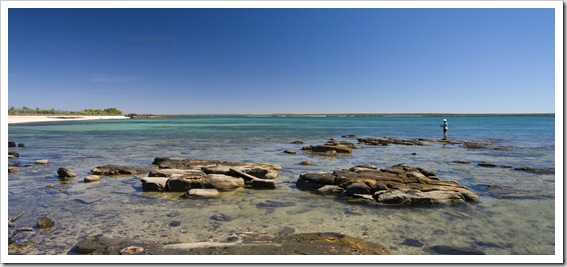 we could camp on their extensive property and after finding a spot a few kilometers north along the coast from the pictured mudflats we decided we just had to spend the night. We setup camp in a small, secluded clearing just behind the sand dunes with a beach to our left and rocky outcroppings to our right (S14°05.792′ E126°42.853′). And to cap it all off we had the place absolutely to ourselves, not a soul to be seen during our stay. We couldn’t have asked for a more picturesque spot, we could see the ocean from our bed and the fishing was amazing to the point of almost being unfair on the fish! We spent the afternoon and morning pulling in everything from cod to bream, Snook to Yellowfin. As we stood there fishing it was hard to keep our concentration on the task at hand, so much wildlife was on show that it was only a tug on the line that reminded us what we were supposed to be doing. A collection of huge White-Breasted Sea Eagles put on quite a show for us, swooping down to the ocean to grab sizeable fish
we could camp on their extensive property and after finding a spot a few kilometers north along the coast from the pictured mudflats we decided we just had to spend the night. We setup camp in a small, secluded clearing just behind the sand dunes with a beach to our left and rocky outcroppings to our right (S14°05.792′ E126°42.853′). And to cap it all off we had the place absolutely to ourselves, not a soul to be seen during our stay. We couldn’t have asked for a more picturesque spot, we could see the ocean from our bed and the fishing was amazing to the point of almost being unfair on the fish! We spent the afternoon and morning pulling in everything from cod to bream, Snook to Yellowfin. As we stood there fishing it was hard to keep our concentration on the task at hand, so much wildlife was on show that it was only a tug on the line that reminded us what we were supposed to be doing. A collection of huge White-Breasted Sea Eagles put on quite a show for us, swooping down to the ocean to grab sizeable fish 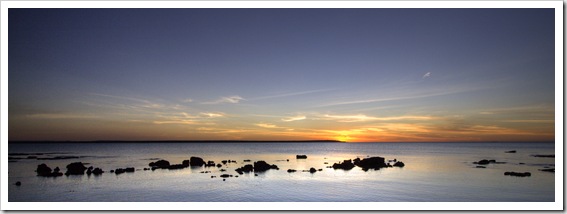 with their talons. Most of the fish we caught we threw back as we were really after the Snook that kept chasing schools of baitfish and dancing across the surface of the water. I pulled in one Snook
with their talons. Most of the fish we caught we threw back as we were really after the Snook that kept chasing schools of baitfish and dancing across the surface of the water. I pulled in one Snook 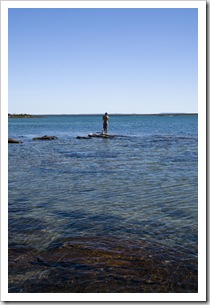 during our afternoon session of fishing, the rest kept cutting our line with their sharp teeth as we attempted to land them. We used a bit heavier tackle the next day, landing a further three good sized Snook as well as some nice Yellowfin, they should provide us with a few meals on the road. The Snook were a hell of a lot of fun to catch, once hooked they’d launch themselves out of the water, flipping and turning in the air in an attempt to dislodge the hook in their mouth. There haven’t been many times in our lives when we’ve quit fishing due to an excess of fish, but we only had so much room to store them in our small fridge!
during our afternoon session of fishing, the rest kept cutting our line with their sharp teeth as we attempted to land them. We used a bit heavier tackle the next day, landing a further three good sized Snook as well as some nice Yellowfin, they should provide us with a few meals on the road. The Snook were a hell of a lot of fun to catch, once hooked they’d launch themselves out of the water, flipping and turning in the air in an attempt to dislodge the hook in their mouth. There haven’t been many times in our lives when we’ve quit fishing due to an excess of fish, but we only had so much room to store them in our small fridge!
Our final night in the Kalumburu area was spent back at the Mission where we could take advantage of the hot showers and an oven in the camp kitchen to bake one of our Snook before heading down to Mitchell Falls. Our secluded campsite on the beach at Pago was pretty special, both of us agreeing that we could have stayed there for a week if only we were able to swim in the ocean!
This entry was posted on Saturday, August 1st, 2009 at 7:30 AM and is filed under Australia, Western Australia. You can follow any responses to this entry through the RSS 2.0 feed. Both comments and pings are currently closed.
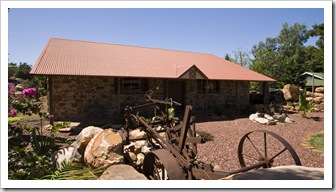
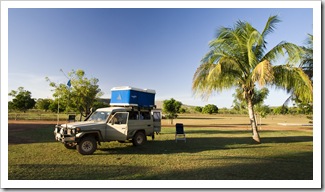
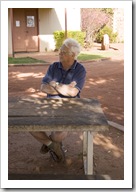
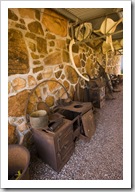

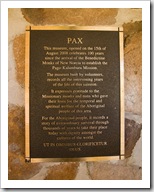
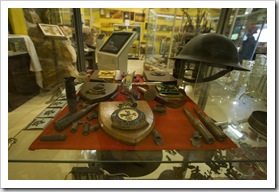
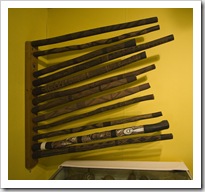
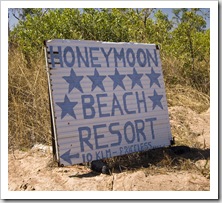
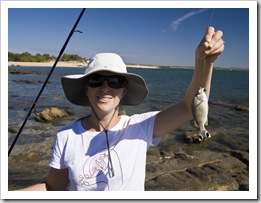
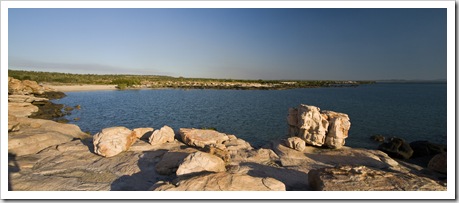
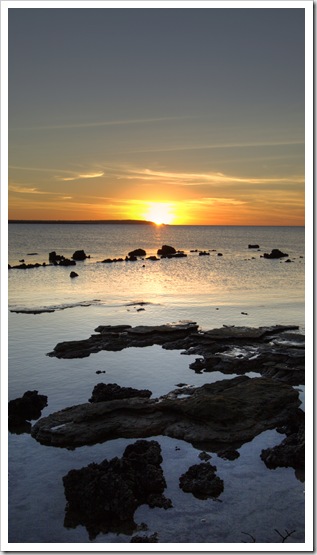
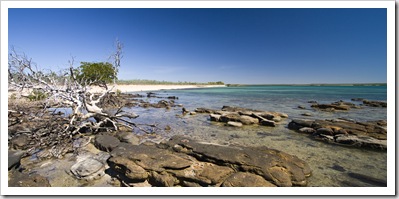
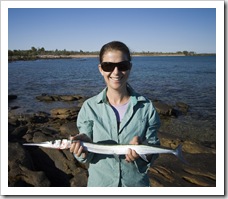
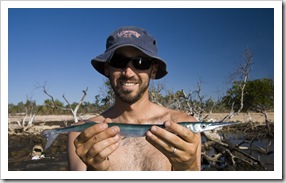
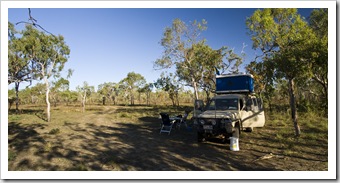
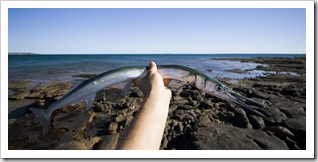

[…] production of beef. Approximately halfway along the Gibb the road tees off and heads north to Kalumburu, a small Aboriginal community on the coast, and also to the famous Mitchell Plateau and Mitchell […]
August 8th, 2009 at 5:14 PM
[…] responsible for the establishment of the mission at the remote Kimberley Aboriginal community of Kalumburu, where we visited on our recent travels through northern Western Australia. The New Norcia […]
November 12th, 2009 at 8:25 AM
I have left the link to mcgowan island campground its http://www.mcgowanisland.com.au.
All the information you need about this fantastic spot is available on their new webpage.
March 18th, 2010 at 8:34 PM
[…] here tracked our travels across the Gibb River Road and up to the isolated Aboriginal settlement of Kalumburu. Fun to see a big close-up of Lisa tackling Devonshire tea at Ellenbrae […]
April 4th, 2010 at 5:36 PM